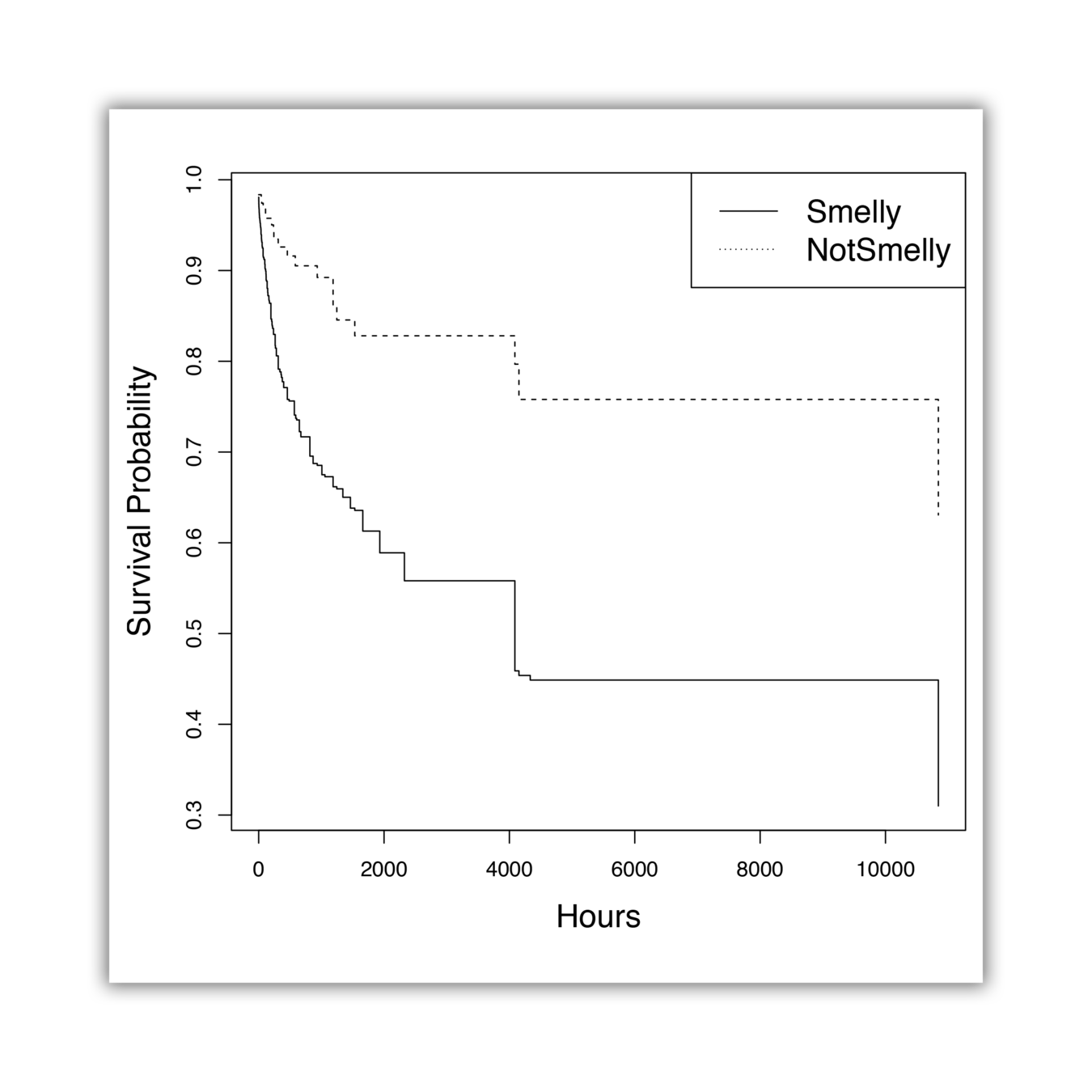On the fault-proneness of
JavaScript Code Smells

Amir Saboury
December 2016
Outline
- Introduction & Background
- Research Objectives
- Literature Review
- Methodology & Design
- Study Results
- Discussion
- Limitations
- Conclusion
- Introduction & Background
- Research Objectives
- Literature Review
- Methodology & Design
- Study Results
- Discussion
- Limitations
- Conclusion
JavaScript


- Introduction & Background
- Research Objectives
- Literature Review
- Methodology & Design
- Study Results
- Discussion
- Limitations
- Conclusion

- Introduction & Background
- Research Objectives
- Literature Review
- Methodology & Design
- Study Results
- Discussion
- Limitations
- Conclusion
Code Smell
The pieces of the codes that scream out to be refactored
– Martin Fowler
- Introduction & Background
- Research Objectives
- Literature Review
- Methodology & Design
- Study Results
- Discussion
- Limitations
- Conclusion
- Introduction & Background
- Research Objectives
- Literature Review
- Methodology & Design
- Study Results
- Discussion
- Limitations
- Conclusion
Research Objectives
RQ1
Is the risk of fault higher in files with code smells in comparison with those without smell?
- Introduction & Background
- Research Objectives
- Literature Review
- Methodology & Design
- Study Results
- Discussion
- Limitations
- Conclusion
RQ2
Are JavaScript files with code smells
equally fault-prone?
- Introduction & Background
- Research Objectives
- Literature Review
- Methodology & Design
- Study Results
- Discussion
- Limitations
- Conclusion
Related Works
- Introduction & Background
- Research Objectives
- Literature Review
- Methodology & Design
- Study Results
- Discussion
- Limitations
- Conclusion
Li and Shatnawi
The relationships between code smells and the occurrence of errors in Eclipse.
Code smells are positively associated with higher error probability.
Khomh et al.
The relationship between code smells and the change- and fault-proneness of 54 releases of four Java open source systems.
Classes with code smells tend to be more change- and fault-prone than other classes.
Fard et al.
JSNOSE: a tool to detect 13 different types of code smells in JavaScript systems.
“lazy object” and “long method/function” are the most frequent code smells.
JavaScript Code Smells
- The detection of code smells.
- The evolution of code smells in software systems and their impact on software quality.
- The relationship between code smells and software development activities.
- Introduction & Background
- Research Objectives
- Literature Review
- Methodology & Design
- Study Results
- Discussion
- Limitations
- Conclusion
Types of Code Smells
JSNose





- Introduction & Background
- Research Objectives
- Literature Review
- Methodology & Design
- Study Results
- Discussion
- Limitations
- Conclusion
Types of Code Smells
- Lengthy Lines
- Long Parameter List
- Long Methods
- Complex code
- Complex Switch Case
- Chained Methods
- Depth
- Variable Re-assign
- Nested Callbacks
- Extra Bind
- This Assign
- Assignment in Conditional Statements
- Introduction & Background
- Research Objectives
- Literature Review
- Methodology & Design
- Study Results
- Discussion
- Limitations
- Conclusion
#8
Variable Re-assign
function parse(url) {
url = url.split('/');
// ...
}- Introduction & Background
- Research Objectives
- Literature Review
- Methodology & Design
- Study Results
- Discussion
- Limitations
- Conclusion
#9
Nested Callbacks
$.get('/info.json', function (err, data) {
log(data, function (err, data) {
// ...
});
});
- Introduction & Background
- Research Objectives
- Literature Review
- Methodology & Design
- Study Results
- Discussion
- Limitations
- Conclusion
#10
Extra Bind
var download = function (url) {
var callback = function (err, data) {
// this.data = data;
console.log(data);
}.bind(this);
$get(url, callback);
}- Introduction & Background
- Research Objectives
- Literature Review
- Methodology & Design
- Study Results
- Discussion
- Limitations
- Conclusion
#11
"this" Assign
var download = function (url) {
var self = this;
var callback = function (err, data) {
self.error = err;
self.data = data;
}
$get(url, callback);
}- Introduction & Background
- Research Objectives
- Literature Review
- Methodology & Design
- Study Results
- Discussion
- Limitations
- Conclusion
#12
Assignment in Conditional Statements
if (element = stack.pop()){
element.addClass("last");
}- Introduction & Background
- Research Objectives
- Literature Review
- Methodology & Design
- Study Results
- Discussion
- Limitations
- Conclusion
Methodology & Design
- Introduction & Background
- Research Objectives
- Literature Review
- Methodology & Design
- Study Results
- Discussion
- Limitations
- Conclusion
Studied Systems, Data Extraction, Analysis
Studied Systems
- Express Web framework
- Request HTTP client utility
- Less.js CSS pre-processor
- Bower.io Package manager
- Grunt Task Runner
- Introduction & Background
- Research Objectives
- Literature Review
- Methodology & Design
- Study Results
- Discussion
- Limitations
- Conclusion
Data Extraction

- Introduction & Background
- Research Objectives
- Literature Review
- Methodology & Design
- Study Results
- Discussion
- Limitations
- Conclusion


- Introduction & Background
- Research Objectives
- Literature Review
- Methodology & Design
- Study Results
- Discussion
- Limitations
- Conclusion
var a = 42;
var b = 5;
function addA(d) {
return a + d;
}
var c = addA(2) + b;Abstract Source Tree

- Introduction & Background
- Research Objectives
- Literature Review
- Methodology & Design
- Study Results
- Discussion
- Limitations
- Conclusion
Data Extraction
File
comit
comit
comit
comit
comit
bug inducing
bug fixing
- Introduction & Background
- Research Objectives
- Literature Review
- Methodology & Design
- Study Results
- Discussion
- Limitations
- Conclusion
Data Extraction

- Introduction & Background
- Research Objectives
- Literature Review
- Methodology & Design
- Study Results
- Discussion
- Limitations
- Conclusion
Code Smell Detection
- Extra Bind
- This Assign
- Assignment in Conditional Statements
- Variable Re-assign
- Lengthy Lines
- Chained Methods
- Long Parameter List
- Nested Callbacks
- Complex code
- Long Methods
- Complex Switch Case
- Depth
Boolean
Number
- Introduction & Background
- Research Objectives
- Literature Review
- Methodology & Design
- Study Results
- Discussion
- Limitations
- Conclusion
Code Smell Detection
Metrics
Code Smells

grunt - nested callbacks

- Introduction & Background
- Research Objectives
- Literature Review
- Methodology & Design
- Study Results
- Discussion
- Limitations
- Conclusion
Data Extraction

- Introduction & Background
- Research Objectives
- Literature Review
- Methodology & Design
- Study Results
- Discussion
- Limitations
- Conclusion
Survival Analysis
Models how long subjects under observation can survive before the occurrence of an event of interest.
- Introduction & Background
- Research Objectives
- Literature Review
- Methodology & Design
- Study Results
- Discussion
- Limitations
- Conclusion
Survival Analysis
Die
Live
Die
Live

- Introduction & Background
- Research Objectives
- Literature Review
- Methodology & Design
- Study Results
- Discussion
- Limitations
- Conclusion
Data Extraction

- Introduction & Background
- Research Objectives
- Literature Review
- Methodology & Design
- Study Results
- Discussion
- Limitations
- Conclusion
Study Results
- Introduction & Background
- Research Objectives
- Literature Review
- Methodology & Design
- Study Results
- Discussion
- Limitations
- Conclusion
RQ1
Is the risk of fault higher in files with code smells in comparison with those without smell?
Approach
Time:
The number of hours between the previous revision and the revision r.
For each file f and revision r:
Covariate of interest:
The presence of a code smell in the file f in the revision r.
Event:
Is the revision r a fault-fixing change?
- Introduction & Background
- Research Objectives
- Literature Review
- Methodology & Design
- Study Results
- Discussion
- Limitations
- Conclusion
Survival Analysis
Cox Proportional Hazard Model
- Subjects can remain in the model for the entire observation period.
- Subjects can be grouped according to a covariate (smelly or non-smelly).
- The characteristics of the subjects might change during the observation period.
- Cox hazard models are adapted for events that are recurrent.
- Introduction & Background
- Research Objectives
- Literature Review
- Methodology & Design
- Study Results
- Discussion
- Limitations
- Conclusion

Request

Less.js

Grunt

Express

Bower
- Introduction & Background
- Research Objectives
- Literature Review
- Methodology & Design
- Study Results
- Discussion
- Limitations
- Conclusion
Log-rank Test
(which compares the survival distributions of two samples)
p-value < 0.05
| JavaScript files without code smells have hazard rates 65% lower than JavaScript files with code smells and this difference is statistically significant. |
|---|
Findings
- Introduction & Background
- Research Objectives
- Literature Review
- Methodology & Design
- Study Results
- Discussion
- Limitations
- Conclusion
Study Results
RQ2
Are JavaScript files with code smells
equally fault-prone?
- Introduction & Background
- Research Objectives
- Literature Review
- Methodology & Design
- Study Results
- Discussion
- Limitations
- Conclusion
Approach
Time, Event
Smelly i
If the file has the code smell type i
LOC, Code Churn, and the number of past bugs
- Introduction & Background
- Research Objectives
- Literature Review
- Methodology & Design
- Study Results
- Discussion
- Limitations
- Conclusion
The hazard ratios of the studied code smells vary across the systems
Express
Chained Methods, This Assign, Variable Re-assign, and #Past-bugs
Grunt
Nested Callbacks, Assignment in Conditional Statements, and Variable Re-assign
Bower
Depth, #Past-bugs, and LOC
Less.js
Assignment in Conditional Statements, and #Past-bugs
Request
Variable Re-assign, and #Past-bugs
- Introduction & Background
- Research Objectives
- Literature Review
- Methodology & Design
- Study Results
- Discussion
- Limitations
- Conclusion
| JavaScript files containing different types of code smells are not equally fault-prone. |
|---|
Refactor files containing "Variable Re-assign" and "Assignment in Conditional Statements" code smell in priority.
Findings
- Introduction & Background
- Research Objectives
- Literature Review
- Methodology & Design
- Study Results
- Discussion
- Limitations
- Conclusion
- Introduction & Background
- Research Objectives
- Literature Review
- Methodology & Design
- Study Results
- Discussion
- Limitations
- Conclusion
Survey
https://srvy.online
Shared in HackerNews & EchoJS
Survey
1484
Participants
- Introduction & Background
- Research Objectives
- Literature Review
- Methodology & Design
- Study Results
- Discussion
- Limitations
- Conclusion
Survey
92% used JS for client-side applications
51% used JS for server-side applications
68% 3+ years of experience with JavaScript
Nested Callbacks (8.1/10)
Variable Re-assign (6.5/10)
Long Parameter List (6.2/10)
- Introduction & Background
- Research Objectives
- Literature Review
- Methodology & Design
- Study Results
- Discussion
- Limitations
- Conclusion
- Introduction & Background
- Research Objectives
- Literature Review
- Methodology & Design
- Study Results
- Discussion
- Limitations
- Conclusion
Limitations
-
Findings bug-fixing commits ("bug", "fix", "defect" etc)
-
SZZ heuristic
-
Presence of the smell in the file as a whole
-
AST provided by ESLint
-
5 JS Systems
Conclusion
Quantitative study of 5 JavaScript systems
JS files without code smells have hazard rates 65% lower than JavaScript files with code smells
"Variable Re-assign" and "Assignment in Cond. Statements" have the highest hazard rates
- Introduction & Background
- Research Objectives
- Literature Review
- Methodology & Design
- Study Results
- Discussion
- Limitations
- Conclusion
- Introduction & Background
- Research Objectives
- Literature Review
- Methodology & Design
- Study Results
- Discussion
- Limitations
- Conclusion
Conclusion
Qualitative study with 1484 JS developers
Nested Callbacks, Variable Re-assign, Long Parameter List
- 5 JavaScript systems
- Extracted information about code smells
- Survival Analysis
"Variable Re-assign" and "Assignment in Conditional Statements"
Different types of code smells are not equally fault-prone.
Files without code smells have 65% lower hazard rates.
- Qualitative study
- Survey with 1484 JS developers
"Nested Callbacks", "Variable Re-assign", "Long Parameter List"
Summary
Thank you

#1
Lengthy Lines
- Introduction & Background
- Research Objectives
- Literature Review
- Methodology & Design
- Study Results
- Discussion
- Conclusion
- Limitations
#2
Long Parameter List
move(x1, y1, x2, y2, direction, speed, steps, onFinish)- Introduction & Background
- Research Objectives
- Literature Review
- Methodology & Design
- Study Results
- Discussion
- Conclusion
- Limitations
#3
Long Methods


* https://sourcemaking.com/refactoring
- Introduction & Background
- Research Objectives
- Literature Review
- Methodology & Design
- Study Results
- Discussion
- Conclusion
- Limitations
#4
Complex code

- Introduction & Background
- Research Objectives
- Literature Review
- Methodology & Design
- Study Results
- Discussion
- Conclusion
- Limitations
cyclomatic complexity
#5
Complex Switch Case

* https://sourcemaking.com/refactoring
- Introduction & Background
- Research Objectives
- Literature Review
- Methodology & Design
- Study Results
- Discussion
- Conclusion
- Limitations
#6
Chained Methods
$('a').find('span').attr('id', 'title').end().click();- Introduction & Background
- Research Objectives
- Literature Review
- Methodology & Design
- Study Results
- Discussion
- Conclusion
- Limitations
#7
Depth
var download = function (url) {
if (url) {
$get(url, function(err, data) {
if (!err) {
if (data.includes('http')) {
//...
}
}
});
}
}- Introduction & Background
- Research Objectives
- Literature Review
- Methodology & Design
- Study Results
- Discussion
- Conclusion
- Limitations
js-smell
By amir
js-smell
- 2,203



